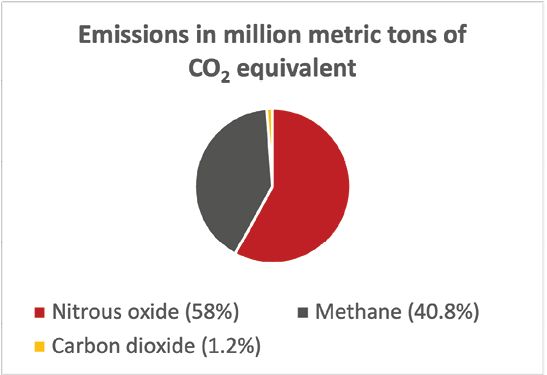Poultry Industry’s Contribution to Greenhouse Gas Emissions
In recent decades, atmospheric concentrations of certain gases have increased rapidly to levels that have not been seen before. It is believed that increasing greenhouse gas (GHG) concentrations will trap heat in the atmosphere and could lead to increased global warming and climate change. As a result, agriculture and other sectors of the economy are under pressure to reduce GHG
emissions.
Agriculture Contributes to GHG Emissions
Agricultural activities contribute directly to GHG emissions through a variety of processes including enteric fermentation in domestic livestock, livestock/poultry manure management, agricultural soil management, field burning of agricultural residues, and rice cultivation. The U.S. EPA (2021) estimated that, in 2019, the agriculture sector was responsible for 9.6 percent of total U.S. GHG emissions. Even though the contribution of agriculture is small compared to some other sectors, understanding how GHGs are generated and what the poultry industry
can do to further reduce its contribution is of great importance.
This is true, in part, because livestock and poultry manures are an important source of GHG emissions. In addition to methane and nitrous oxide, ammonia is also produced from animal manures. Ammonia decomposes after deposition in soil or oxidizes in the air and can produce nitrous oxide, indirectly affecting production and emission of GHGs (Xie et al., 2002). Ammonia is also one of the main sources of fine particulate matter formation (Zhu et al., 2020). Hristov (2011) reported that ammonia emissions from U.S. livestock production contributed 5 to 15 percent of U.S. particulate matter.
Clarisse et al. (2009) reported that ammonia released from decomposition of livestock wastes could account for 39 percent of the total amount of ammonia in the atmosphere. Therefore, control of both ammonia and GHG emissions from livestock and poultry industries is important to reduce the impact of the agriculture sector on global warming.
What are Greenhouse Gases?
Earth’s atmosphere consists mainly of nitrogen, oxygen, argon, and trace amounts of other gases whose concentrations vary little over time and location. Greenhouse gases are those that can absorb and emit thermal radiation (heat) that would otherwise be lost into space. These gases can prevent heat from radiating or reflecting away from Earth and may result in global warming and climate change (Dunkley, 2011).
Many GHGs occur naturally in the atmosphere, such as water vapor (H2O), carbon dioxide (CO2), methane (CH4), ozone (O3), and nitrous oxide (N2O), while others are synthetic (Smith, 2014a). Synthetic GHGs include chlorofluorocarbons (CFCs), hydrofluorocarbons (HFCs), and perfluorocarbons (PFCs), as well as sulfur hexafluoride (SF6). While they make up only a small fraction of all gases in the atmosphere, these gases play a key part in regulating Earth’s temperature. The average global surface temperature of Earth is approximately about 59°F (15°C) (Pidwirny, 2006). Without GHGs, average global surface temperature would be about 0°F (-18°C).
Carbon dioxide, CH4, and N2O comprise almost 98 percent of GHGs in the atmosphere, all of which are important byproducts of human activity, including animal agriculture (NAMI, 2009). Greenhouse gases differ in the amount of heat they can absorb and how long they remain in the atmosphere (their CO2 equivalent, or global warming potential).
The global warming potential (GWP) compares the amount of heat trapped by a certain amount of gas in question to the amount of heat trapped by a similar amount of carbon dioxide, usually calculated over a 100-year time interval. Grossi et al. (2019) indicated that CH4 has a GWP 28 times higher than CO2 while N2O has a GWP 265 times that of CO2. This means that if the same amount of CH4, N2O, and CO2 were emitted into the atmosphere, CH4 and N2O would trap 28 and 265 times more heat respectively, than CO2 over a 100-year period. Figure 1 outlines GHG emissions from various agricultural activities.

The primary GHG sources from agriculture are N2O emissions from cropped and grazed soils, CH4 emissions from ruminant livestock production and rice cultivation, CH4 and N2O emissions from managed livestock manure/waste, and CO2 emissions from on-farm energy use (USDA, 2016). Methane is emitted when organic carbon compounds break down under anaerobic conditions. These conditions may occur in the soil, in stored manure, in an animal’s digestive tract during enteric fermentation (common in ruminants), or during incomplete combustion of burning organic matter. Nitrous oxide is primarily emitted as a by-product of nitrification (aerobic transformation of ammonium to nitrate) and denitrification (anaerobic transformation of nitrate to nitrogen gas), common when fertilizers are used (Dunkley, 2014).
Greenhouse gas emissions from managed livestock waste are composed of CH4 and N2O from livestock waste storage, transport, and treatment and CH4 emissions from the spread of livestock waste. Methane was the predominant GHG emitted from managed livestock waste in 2013, accounting for 78 percent of total emissions from this source (USDA, 2016). Nitrous oxide accounted for the remaining 22 percent of GHG emissions from managed livestock waste.
Dairy cattle and swine were responsible for 37 and 25 percent of total managed livestock waste emissions, respectively, while beef cattle (8 percent) and poultry (5 percent) were also important sources. Emissions from managed waste increased by 14 percent from 1990 to 2013. Most of the increase was a result of higher CH4 emissions related to the trend of storing more waste in liquid systems and anaerobic lagoons which increases CH4 production (USDA, 2016). When manure sits for more than a couple days in an anaerobic environment, methane will likely be produced (Smith, 2014a). About half of all manure methane emissions are attributed to dairy cattle, followed by swine (19 percent), beef cattle (5 percent), and poultry (5 percent) (U.S. EPA, 2013).
Much of the poultry industry’s CO2 equivalent is primarily from use of fossil fuels. From a poultry grower’s perspective, this will include purchased electricity to operate equipment in poultry houses (lights, fans, feeders, etc.), brooders (to keep young chicks warm), incinerators, and diesel fuel used in trucks, tractors, and standby generators (Dunkley, 2011). The consumption of feed (plant protein) by animals eventually results in the division of carbon into animal biomass (meat and eggs), CO2 respired by the animals, and manure deposition. Naturally, the amount of manure produced depends on the size and number of animals reared and the rate of manure production (Dunkley, 2011).
Mitigating GHG Emissions
Mitigation, in relation to climate change, is any practice that reduces the net amount of GHGs released into the atmosphere. Mitigation strategies in animal agriculture are generally divided into four main categories:
- production efficiency
- manure management
- energy efficiency
- carbon sequestration
Improving production efficiency will increase output of meat, milk, and eggs per unit of input, thereby reducing GHG emissions per unit of product produced (Smith, 2014b). Proper manure management will reduce GHG emissions and has the added benefit of protecting air and water quality. Installing energy efficient lighting such as LED lamps, along with efficient heating and cooling systems, will lessen GHG emissions and reduce energy bills. Carbon sequestration increases organic matter in soils. However, because of the wide diversity in livestock and poultry production systems and differences in farm operation management practices, identifying effective mitigation strategies is often challenging.
For example, Dunkley (2011) reported that about 65 percent of GHG emissions from broiler and pullet farms were from propane use (used for brooding young birds during colder periods of the year), while only 0.3 percent of emissions from breeder farms were from propane use. However, on breeder farms, Dunkley (2011) indicated that about 85 percent of GHG emissions were the result of electricity used for lighting and ventilation, while pullet and broiler farms had 30 and 29 percent emissions, respectively, from electricity use.
Every farming operation is different and poultry growers must determine where the largest gains in efficiency can be realized on their operation. Many poultry houses have been upgraded to varying degrees in recent years to improve their production and energy efficiency. However, there are still numerous houses with room for improvement in the areas of propane and electricity use and manure management.
Summary
Climate change has the potential to adversely impact agricultural productivity on a local, regional, and global scale. Altered rainfall patterns, increased occurrences of climate extremes (high temperatures and drought), changing pest pressure, and alterations in seasonal and diurnal temperature patterns will impact national and international markets; prices for food, fiber, and energy; agricultural incomes; and the environment. How farmers ultimately adapt to these changing conditions will determine their impact on agricultural production, natural resources, and food security in the future.
In 2019, the EPA estimated that the agriculture sector was responsible for 9.6 percent of all U.S. GHG emissions. This is a small percentage compared to other sectors such as transportation and industry. However, agriculture is on the public’s radar and is expected to do more to reduce GHG emissions. And there is more agriculture (in general) and the poultry industry (specifically) can do. Changes in agricultural production practices could result in reduced GHG emissions and removal of carbon dioxide from the atmosphere through carbon sequestration.
Improving poultry production efficiency will reduce GHG emissions per unit of product (meat and eggs). Using best management practices when handling and storing poultry litter and manure will reduce GHG emissions and protect air and water quality. Use of energy efficient LED lighting and high efficiency fans will reduce both GHG emissions and farm utility bills. Every farming operation is different and likely some practices will have more implementation value than others, depending on each farm’s individual circumstances. However, the overall goal is to take full advantage of all mitigation practices and work to improve efficiency to reduce the poultry industry’s contribution to GHG emissions.
References
Clarisse, L., C. Clerbaux, F. Dentener, D. Hurtmans, & P.-F. Coheur. (2009). Global ammonia distribution derived from infrared satellite observations. Nat. Geosci. 2(7):479–483.
Dunkley, C. S. 2011. Global warming: How does it relate to poultry. University of Georgia Extension Bulletin No. 1382.
Grossi, G., P. Goglio, A. Vitali, & A. G. Williams.(2019). Livestock and climate change: impact of livestock on climate and mitigation strategies. Anim. Front. 9(1):69–76.
Hristov, A. N. (2011). Technical note: Contribution of ammonia emitted from livestock to atmospheric fine particulate matter (PM2.5) in the United States. J. Dairy Sci. 94(6):3130–3136.
North American Meat Institute. (2009). Climate change and animal agriculture: The facts. https://www.meatinstitute.org/index.php?ht=d/sp/i/47385/pid/47385. Retrieved March 4, 2021.
Pidwirny, M. (2006). The Greenhouse Effect. Fundamentals of Physical Geography, 2nd Ed – Chapter 7. http://www.physicalgeography.net/fundamentals/7h.html. Retrieved March 3, 2021.
Smith, D. W. (2014a). Contribution of greenhouse gas emissions: Animal agriculture in perspective. Animal Agriculture in a Changing Climate. https://baen.tamu.edu/extension/publications/climate-change/. Retrieved March 3, 2021.
Smith, D. W. (2014b). Mitigation of greenhouse gas emissions in animal agriculture. Animal Agriculture in a Changing Climate. https://baen.tamu.edu/extension/publications/climate-change/. Retrieved March 4, 2021.
United States Department of Agriculture. (2016). U.S. Agriculture and Forestry Greenhouse Gas Inventory 1990-2013. Technical Bull. No. 1943. https://www.usda.gov/sites/default/files/documents/USDA_GHG_Inventory_1990-2013_9_19_16_reduced.pdf. Retrieved March 4, 2021.
United States Environmental Protection Agency. (2013). Inventory of U.S. Greenhouse Gas Emissions and Sinks: 1990-2011. Chapter 6. Agriculture. https://www.epa.gov/ghgemissions/inventory-us-greenhouse-gas-emissions-and-sinks-1990-2011. Retrieved March 2, 2021.
United States Environmental Protection Agency. (2021). Draft Inventory of U.S. Greenhouse Gas Emissions and Sinks: 1990-2019. (EPA 430-R-21-001). https://nepis.epa.gov/Exe/ZyPURL.cgi?Dockey=P10114TW.txt. Retrieved March 3, 2021.
Xie, J., Y. Li, and H. Dong. (2002). Emission of nitrous oxide and ammonia from closed composting bins containing layer-hen manure. Agro-environ. Prot., 21(6):524–526.
Zhu, Z., L. Li, H. Dong, & Y. Wang. (2020). Ammonia and greenhouse gas emissions of different types of livestock and poultry manure during storage. Trans ASABE, 63(6):1723–1733.
Publication 3634 (POD-05-21)
By Tom Tabler, PhD, Extension Professor, MSU Poultry Science; Jessica Wells, PhD, Assistant Clinical/Extension Professor, MSU Poultry Science; and Jonathan Moon, Poultry Operation Coordinator, MSU Poultry Science
The Mississippi State University Extension Service is working to ensure all web content is accessible to all users. If you need assistance accessing any of our content, please email the webteam or call 662-325-2262.




